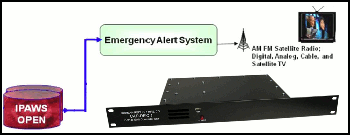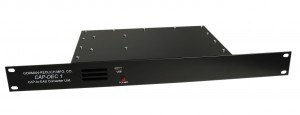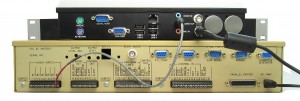
CAP-DEC 1 CAP-to-EAS Converter
Additional Images
Features
Specifications
Product Documents
FAQ/Troubleshooting
Additional Info
CLICK HERE to sign up for Gorman Redlich Common Alerting Protocol (CAP) update emails. Been let down by EAS equipment no longer supported by other manufacturers? Contact us to request a quote on compliant, fully-supported EAS equipment compatible with the CAP-DEC1 Universal Intermediary Device. We also offer high quality, versatile AM/FM/WX radio tuners for receiving messages from your Over-the-Air (OTA) monitoring assignments.
The emergency alerting experts at Gorman-Redlich have the answer in the form of the Gorman-Redlich CAP-DEC1 CAP-to-EAS converter unit. This standalone unit translates received CAP alerts into EAS headers, which will be transmitted by your current EAS equipment. The CAP-DEC1 unit is classified by the FCC as an intermediary CAP device and functions as a universal intermediary device, outputting AFSK data tones which can be used as an input to any certified encoder/decoder. For those who wish to upgrade their current EAS encoder/decoder units as well as conform to the FCC mandate, development is underway on a combination EAS encoder/decoder/CAP-to-EAS converter unit.
The Gorman-Redlich CAP-DEC1 CAP-to-EAS unit has passed the Integrated Public Alert and Warning System Conformity Assessment (IPAWS-CA) testing at the FEMA-contracted SAIC lab in Somerset, Kentucky, which verifies conformity with the CAP v1.2, IPAWS Profile and ECIG specifications. More details are available in the FEMA Responder Knowledge Base (RKB).
Already have a CAP-DEC system? Click Here for software update information.
Click here for the FAQ about the CAP-DEC unit and Windows 10.
Click here for information about compliance with the latest FCC R&O.
Features
Built by the experts with 35 years of experience in the emergency alerting industry, the CAP-DEC1 offers the following features:
- RJ45 Ethernet LAN connection for network/internet receipt of CAP alerts.
- Remote access via optional VNC interface (not included by default).
- Frequency Shift Keyed (FSK) output of CAP-to-EAS translated alerts for compatibility with a wide range of legacy EAS equipment.
- Monitors up to three (3) CAP alert server URLs (expandable for additional monitoring).
- Internal logging of CAP-to-EAS translation activity.
- Internal storage of received CAP alerts and attached audio files.
- Ability to log activity to USB or network printer.
- Ability to send activity logs via email server (SMTP server configuration required).
- Enhanced text generation and output for crawl/page display.
- Simple to connect, easy to use. Only three connections required for operation.
- Easy configuration and monitoring using attached keyboard, mouse, and VGA monitor or remote access.
- Text-to-speech converter to generate alert audio if no audio is included with received alert.
- Standalone unit; does not require purchase of new encoder-decoder
- Software updates via LAN or USB
- One rack unit space requirement for small equipment footprint
- Ability to store legacy EAS logs electronically instead of using a printer.
Technical Specifications
The CAP-DEC1 helps you meet the CAP requirement using the latest technology:
- CAP 1.2 compatible
- Powerful 1.66 GHz dual core Intel Atom processor
- 1GB of RAM
- 80GB on-board storage for log files and message/audio archives (upgradable to higher capacities)
- 100+ year MTBF solid state storage for cool, quiet, reliable, shock-resistant performance
- 10/100/1000 Gigabit LAN connection for fast network connectivity
- Five (5) USB ports for attaching printers, storage devices, network adapters, etc.
- Two (2) RS232 serial ports
- Built-in text-to-speech converter
- External SMTP email support
- Automatically updates and synchronizes clock via pre-configured NTP servers
- Built-in firewall for network security
- Polls RSS/ATOM feeds, MyStateUSA and DM/IPAWS-OPEN servers to receive CAP alerts
- Decoding and playing attached MP3 alert audio (downloaded and included dereferenced files)
- 1/8″ TRS jacks for audio in, audio out, and microphone in
- FCC ID: MVZCAP-DEC1
Product Documentation
CAP-DEC 1 User Guide
Understanding CAP Converters article
Electronic EAS Logging with EASMon Software
Dynamic test feeds
Security Certificate Installation Instructions
Additional Product Images
Additional Information
IPAWS Feed

CLICK HERE for information about about the FEMA IPAWS alert aggregator feed
Beginning December 12, 2011, Required Weekly Tests (RWTs) are available via the FEMA IPAWS alert aggregator feed.
Text-to-Speech is a “Go”
 In their Fifth R&O, the FCC has deferred the decision on whether to allow the use of text-to-speech (TTS) technology at CAP end points (i.e. EAS participant locations) to a later date. On April 19, 2012, the FCC released their review of the TTS issue, which contains the following summation of their current stance:
In their Fifth R&O, the FCC has deferred the decision on whether to allow the use of text-to-speech (TTS) technology at CAP end points (i.e. EAS participant locations) to a later date. On April 19, 2012, the FCC released their review of the TTS issue, which contains the following summation of their current stance:
“With these revisions, we hereby defer consideration of the ECIG Implementation Guide’s adoption of TTS software configured in EAS equipment to generate the audio portion of an EAS message, and thus neither require nor prohibit EAS Participants from following the ECIG Implementation Guide’s specifications on use of TTS.”
Sixth R&O considerations
Gorman-Redlich CAP-DEC 1 devices treat the all-zero (000000) location code as a “wild card” location. If it receives an alert with such a location included in it, it marks it as “in area” and continues processing the alert as usual for transmission to the attached EAS device.
The CAP-DEC 1 will also pass valid messages sent with the National Periodic Test (NPT) header code.
Provided that the attached EAS device is capable of handling the above message elements, this equipment will meet the requirements of the 6th Report and Order. The latest builds of the firmware for EAS 1 TV/CG units (20.9+) and original EAS 1 units (v9.8+) already handle these requirements.
Click HERE for a note about 6th R&O support for discontinued TFT EAS equipment.



